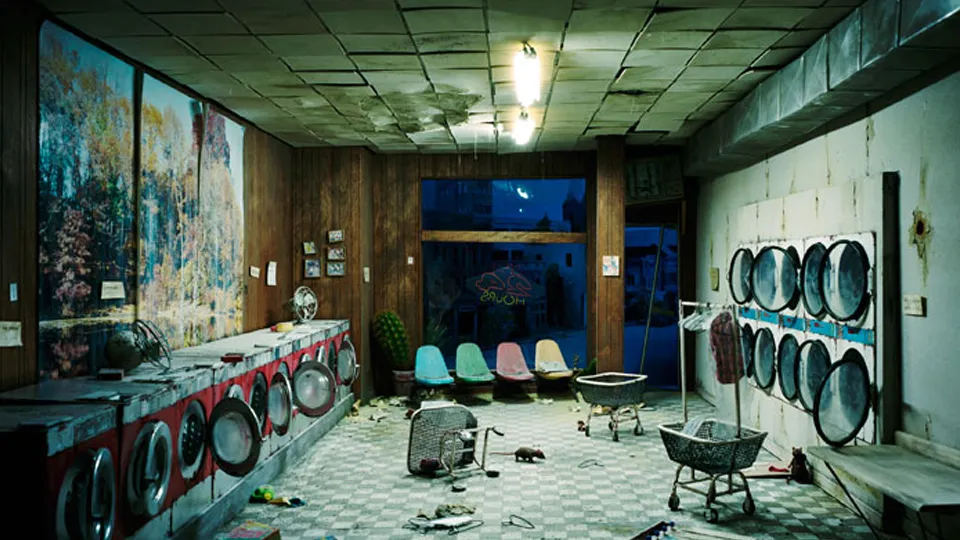Fashion has always reflected humanity’s deepest anxieties, and today’s apocalyptic aesthetic speaks volumes about our collective fears and survival instincts in uncertain times.
🌑 When Runway Meets Armageddon: The Rise of Survivalist Style
The fashion industry has always possessed an uncanny ability to channel the zeitgeist into wearable art, but nothing quite captures our current moment like the emergence of apocalyptic chic. This isn’t simply about distressed denim or edgy accessories anymore. We’re witnessing a fundamental shift where haute couture meets hardcore survivalism, where Balenciaga collaborates conceptually with bunker builders, and where the line between fashion statement and legitimate disaster preparedness gear becomes increasingly blurred.
Apocalyptic fashion represents more than aesthetic rebellion. It embodies our generation’s response to climate catastrophe, political instability, pandemic threats, and technological disruption. When Demna Gvasalia sends models down runways wrapped in garbage bags or Rick Owens designs collections that look ripped from a Mad Max sequel, they’re not just being provocative—they’re holding up a mirror to civilization’s fragile facade.
This survivalist fashion movement emerged gradually from multiple sources: the grunge aesthetic of the 1990s, cyberpunk’s dystopian visions, military surplus culture, and the practical demands of urban exploration. But what once lived on society’s fringes has now infiltrated mainstream consciousness, appearing everywhere from Supreme drops to luxury fashion houses to everyday streetwear.
💀 The Aesthetic of Decline: Design Elements That Define Apocalyptic Chic
Apocalyptic fashion possesses distinct visual markers that separate it from mere grunge revival or military-inspired streetwear. Understanding these elements reveals how deeply this aesthetic has penetrated contemporary style consciousness and what psychological needs it fulfills for wearers navigating an increasingly unstable world.
Utilitarian Functionality Meets High Fashion
The most defining characteristic of apocalyptic chic is its marriage of genuine functionality with avant-garde design sensibility. Garments feature multiple pockets, modular components, weather-resistant materials, and convertible elements that serve actual survival purposes while maintaining aesthetic coherence. Brands like Acronym and Guerrilla-Group have built entire identities around this philosophy, creating jackets with 40+ pockets, pants that convert to shorts, and fabrics that resist water, wind, and abrasion.
These aren’t costume pieces. They’re genuinely functional garments that could legitimately help someone survive harsh conditions, navigate urban environments, or carry essential supplies. Yet they’re styled with enough design sophistication to appear on fashion week runways and command premium prices from style-conscious consumers.
Distressed Textures and Deconstructed Silhouettes
Apocalyptic fashion embraces imperfection, decay, and deconstruction as aesthetic principles. Frayed edges, deliberately torn fabrics, exposed seams, and asymmetrical cuts suggest garments that have survived hardship. This distressed aesthetic communicates resilience—these clothes have seen things, survived situations, and emerged battle-worn but functional.
Designers like Yohji Yamamoto and Ann Demeulemeester have long explored deconstruction, but contemporary survivalist fashion pushes this further by making the destruction look less artistic and more authentically weathered. The goal isn’t beautiful decay but convincing wear that suggests genuine use in harsh conditions.
Neutral Color Palettes and Tactical Hues
Apocalyptic chic overwhelmingly favors blacks, grays, olive drabs, and earth tones—colors that serve camouflage purposes, hide dirt, and blend into urban or natural environments. These palettes reject the attention-seeking brightness of conventional fashion in favor of visual stealth and practical concealment.
When brighter colors do appear, they’re typically deployed strategically: safety orange for visibility, reflective elements for night navigation, or military-inspired patches and details that reference tactical gear. Every color choice serves purpose beyond pure aesthetics.
🔥 From Catwalks to Cataclysm: High Fashion’s Doomsday Obsession
Luxury fashion houses have increasingly embraced apocalyptic themes, transforming survivalist aesthetics into high-art statements that command extraordinary prices while commenting on societal collapse. This isn’t appropriation so much as acknowledgment—the fashion elite recognizing that their industry exists within the same crumbling civilization as everyone else.
Balenciaga’s recent collections epitomize this trend. Creative director Demna Gvasalia has presented models trudging through snowstorms, wrapped in oversized puffer coats that resemble sleeping bags, carrying trash-bag-like accessories, and wearing clothing that deliberately evokes refugee crises and displacement. These collections generated controversy, but they also sold remarkably well to consumers who recognized their own anxieties reflected in the designs.
Rick Owens has built an entire aesthetic empire around post-apocalyptic Gothic sensibilities. His DRKSHDW line combines punk rebellion with survivalist practicality, creating garments that look equally appropriate at underground raves or actual civilization collapse. Models in his shows often appear as warrior-priests of some future dark age, wearing elongated silhouettes and architectural layering that suggests both protection and ceremony.
Even traditionally conservative houses have dipped into these waters. Prada has experimented with nylon utility pieces and industrial aesthetics. Louis Vuitton has produced collections featuring survival-inspired accessories and technical fabrics. The apocalyptic sensibility has permeated fashion at every level, from experimental avant-garde to accessible ready-to-wear.
🎒 Streetwear’s Survival Instinct: Democratizing Doomsday Fashion
While luxury houses philosophize about civilization’s end through expensive artistic statements, streetwear brands have made apocalyptic fashion accessible, practical, and genuinely useful for everyday life. This democratization has allowed survivalist aesthetics to influence how millions actually dress, not just what they admire on runways.
Brands like Arc’teryx Veilance, Stone Island, and Carhartt WIP bridge the gap between technical outdoor gear and urban fashion. Their pieces offer genuine weather protection, durability, and functionality while maintaining style credibility. A Veilance jacket costs significantly less than a Balenciaga statement piece but offers superior actual survival utility alongside comparable aesthetic appeal.
The techwear movement represents streetwear’s most explicit embrace of survivalist principles. Online communities dedicated to techwear share outfit combinations that maximize carrying capacity, weather resistance, and mobility while achieving cohesive visual aesthetics. These enthusiasts treat dressing as problem-solving, considering scenarios their outfits might need to handle and optimizing accordingly.
Japanese brands particularly excel in this space. Acronym creates garments with engineering precision, where every zipper, panel, and pocket serves specific functions. Their pieces cost thousands but offer unmatched versatility—single jackets that perform across seasons, climates, and situations through modular design and advanced materials.
🧬 Materials Science Meets Fashion: The Technology Behind Survival Style
Apocalyptic fashion’s functionality depends heavily on advanced materials that barely existed decades ago. These technical fabrics allow garments to perform genuinely useful survival functions while maintaining aesthetic appeal and comfort for everyday wear.
Gore-Tex and similar waterproof-breathable membranes represent the foundation, keeping wearers dry without causing overheating. Ripstop fabrics resist tearing and abrasion. Schoeller textiles offer stretch, durability, and weather resistance simultaneously. Insulation technologies like PrimaLoft and Polartec provide warmth without bulk. Dyneema composite fabrics deliver strength-to-weight ratios that allow impossibly light yet tough garments.
These materials originated in military, mountaineering, and technical outdoor contexts but have migrated steadily into fashion spaces. Brands now market technical specifications alongside style features, expecting consumers to care about denier ratings, water column measurements, and breathability metrics as much as silhouette and color.
Sustainable technology adds another dimension. Recycled polyesters, organic cottons, and biodegradable synthetics allow environmentally-conscious consumers to prepare for ecological collapse without contributing to it. Brands like Patagonia and Outermark have built identities around this paradox—creating durable goods designed for long-term use while minimizing environmental impact.
🌍 Cultural Anxieties Woven Into Fabric: What Apocalyptic Fashion Really Means
Fashion never exists in vacuum. Apocalyptic chic’s rise directly correlates with increasing societal anxieties about climate change, economic instability, political polarization, pandemic threats, and technological disruption. When civilization feels fragile, people dress for its potential collapse.
This phenomenon isn’t new. Previous eras of instability produced similar fashion responses. Punk emerged during 1970s economic crisis and political disillusionment. Grunge reflected 1990s generational anxiety. But apocalyptic chic feels different in scope and sincerity—less rebellion against stability and more practical preparation for its absence.
Younger generations particularly embrace survivalist aesthetics, having come of age during climate crisis awareness, economic precarity, pandemic lockdowns, and political chaos. For Millennials and Gen Z, apocalyptic fashion doesn’t feel performative or ironic—it feels realistic. These generations genuinely expect to face environmental refugees, resource scarcity, and infrastructure collapse during their lifetimes.
The fashion industry’s embrace of these themes validates these anxieties while profiting from them. Critics argue this represents crass commercialization of genuine crisis, turning survival into commodified aesthetic consumption. Defenders counter that fashion always reflects its time, and apocalyptic chic at least acknowledges reality rather than perpetuating fantasies of endless growth and stability.
🛡️ Practical Survivalism: When Fashion Actually Prepares You for Disaster
Beyond aesthetics and cultural commentary, some apocalyptic fashion genuinely serves preparedness purposes. For people taking survival seriously, clothing choices matter significantly in actual emergency scenarios.
A well-designed tactical jacket can carry essential supplies, provide weather protection, and include emergency features like whistle zippers, reflective elements, and internal organization systems. Quality boots offer ankle support, waterproofing, and durability necessary for evacuating on foot. Modular clothing systems allow adaptation to changing conditions with minimal carried weight.
The prepper community has long understood these principles, but their aesthetic typically leaned heavily tactical and explicitly military. Apocalyptic fashion’s innovation involves making genuinely functional survival clothing that doesn’t immediately identify the wearer as a prepper or survivalist. This discretion itself serves survival purposes in scenarios where advertising preparedness might attract unwanted attention.
Layering systems borrowed from mountaineering provide another practical element. Base layers for moisture management, insulation layers for warmth, and shell layers for weather protection allow adaptation to varied conditions using the same garment collection. Fashion brands have adopted this three-layer approach while styling it for urban environments.
💸 Economics of the Apocalypse: Who Can Afford to Look Ready?
Apocalyptic fashion presents troubling economic paradoxes. The most effective survival clothing often costs thousands of dollars—Acronym jackets exceed $2,000, Arc’teryx Veilance pieces approach similar prices, and custom techwear outfits easily surpass $5,000. This creates situations where those most vulnerable to societal collapse can least afford gear that might help them survive it.
Luxury survivalist fashion particularly embodies this contradiction. Balenciaga’s trash bag-inspired totes cost over $1,000. Rick Owens’ post-apocalyptic boots exceed $1,500. These pieces reference deprivation and hardship while remaining accessible only to economic elites insulated from actual survival scenarios.
However, more accessible alternatives exist. Military surplus offers genuine functionality at minimal cost. Budget outdoor brands like Decathlon provide technical features without luxury markups. DIY modification communities share knowledge about upgrading affordable base garments with added functionality. The aesthetic can be achieved across price points, even if premium examples dominate fashion coverage.
This economic stratification raises questions about who gets to participate in survivalist culture and preparedness more broadly. If collapse comes, will expensive technical clothing significantly advantage wealthy wearers, or will practical knowledge and community connections matter more than gear quality? Fashion can’t answer these questions, but it certainly reflects them.
🎭 Identity and Performance: What Your Apocalypse Outfit Says About You
Like all fashion, apocalyptic chic communicates identity—but what exactly does it signal? Wearers might be expressing genuine preparedness mindset, cultural awareness, aesthetic preference, or simply following trends without deeper consideration.
For some, survivalist fashion represents authentic lifestyle alignment. These individuals genuinely prepare for potential collapse through food storage, skill development, and community building. Their clothing choices reflect practical priorities and serve real preparedness functions. They’re dressing for the apocalypse they actually expect.
Others adopt the aesthetic for its cultural cachet and visual appeal without survival intentions. They appreciate the silhouettes, color palettes, and design sophistication without contemplating actual gear functionality. For them, apocalyptic fashion is style statement, not survival preparation—which is perfectly valid as fashion always serves multiple purposes.
A third group exists somewhere between—people experiencing genuine anxiety about the future who find psychological comfort in wearing clothing that feels protective and practical. Even if they’re not actively prepping, the aesthetic helps them feel more prepared, exercising some control in uncontrollable times.
These different motivations coexist within the same aesthetic space, creating interesting tensions between authenticity, performance, and genuine utility. Someone can appreciate technical jackets purely aesthetically while another person relies on identical garments for actual wilderness expeditions or disaster preparedness.
🔮 Future Shock: Where Survivalist Fashion Goes From Here
As environmental pressures intensify, political instability continues, and technological disruption accelerates, apocalyptic fashion will likely evolve rather than disappear. Several trends suggest possible future directions for survivalist style.
Climate adaptation will increasingly influence design. Garments that manage extreme heat, filter polluted air, harvest water, or protect against UV radiation will become normalized as these threats intensify. Fashion will incorporate technologies currently reserved for specialized protective equipment.
Smart textiles and wearable technology integration will advance. Clothing that monitors vital signs, provides navigation assistance, generates power, or communicates emergency information will migrate from concept to reality. Survivalist fashion will become increasingly functional through electronic augmentation.
Sustainability and durability will grow more important as fast fashion becomes environmentally and economically unsustainable. Apocalyptic fashion’s emphasis on quality, longevity, and repairability positions it well for this shift. The aesthetic already celebrates wear and aging rather than demanding pristine newness.
Community-focused design may emerge more prominently. Rather than individual survivalist aesthetics, fashion might reflect mutual aid principles and collective resilience. Garments could facilitate sharing, cooperation, and interdependence rather than solitary preparedness.
🌪️ Dressing for Tomorrow’s Ruins Today
Apocalyptic chic represents far more than trendy pessimism or aesthetic opportunism. It embodies genuine cultural transformation in how we understand fashion’s relationship to environment, society, and survival. When civilization feels uncertain, we dress accordingly—and there’s profound honesty in that response.
This fashion movement succeeds by serving multiple needs simultaneously. It provides psychological comfort through preparedness aesthetics. It offers genuine functionality for practical emergencies. It creates tribal identity for people sharing worldviews and anxieties. It allows artistic expression of cultural moment. It challenges conventional fashion’s obsession with pristine newness and seasonal obsolescence.
Whether you wear apocalyptic fashion for style, survival, or somewhere between, you’re participating in broader cultural conversation about humanity’s trajectory and individual agency within systemic uncertainty. Your clothing choices become statements about which futures seem plausible and how you intend to face them.
The rise of survivalist fashion doesn’t necessarily mean collapse is imminent—but it definitely means enough people believe it possible that dressing for disaster has become mainstream. That shift itself tells us something important about our collective psychology and the times we’re living through. Fashion, as always, reveals truths we might otherwise ignore.
So whether you’re investing in technical outerwear for genuine preparedness, adopting the aesthetic for its visual appeal, or simply trying to understand this cultural phenomenon, recognize that apocalyptic chic matters beyond superficial trends. It’s fashion processing civilization-scale anxiety, offering whatever small comfort clothing can provide when facing an uncertain future. And in these times, that comfort—practical, psychological, or aesthetic—might be exactly what we need.
Toni Santos is a visual explorer and microscopic storyteller who delves into the hidden aesthetics of microbial life. Through a fusion of scientific curiosity and artistic insight, Toni transforms the overlooked world of bacteria, fungi, and cellular forms into mesmerizing visual narratives—revealing the elegance, symmetry, and chaos that thrive at microscopic scales.
Rooted in a fascination with life forms too small to see yet too intricate to ignore, Toni’s work captures the bizarre beauty of microbial colonies, biofilms, and spore patterns. These images aren’t just representations—they are celebrations of the artistic intelligence encoded in nature’s tiniest architects.
With a background in visual design and bio-inspiration, Toni merges scientific imaging techniques with creative expression, transforming petri dish cultures, fluorescence microscopy, and microbial textures into works that provoke both wonder and contemplation.
As the creative force behind Vizovex, Toni offers curated visual studies, microbial-inspired designs, and essays that bridge art and microbiology—inviting viewers to reimagine what beauty means at the edge of perception.
His work is a tribute to:
The hidden geometries of living systems
The surprising elegance of microbial growth
The role of micro-life in shaping visual culture
Whether you’re a scientist, artist, or simply curious about the unseen world that sustains us, Toni opens a window into a universe where life writes poetry in colonies and patterns, one microbe, one frame, one breathtaking detail at a time.





